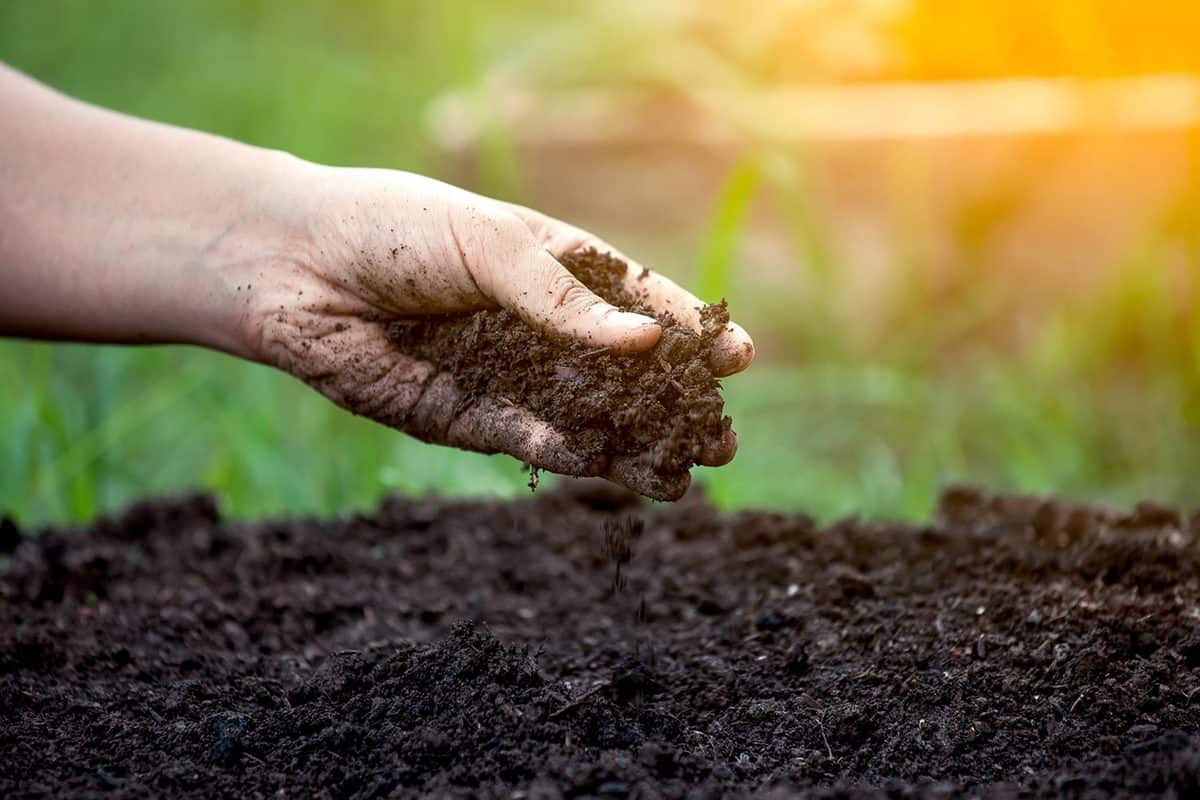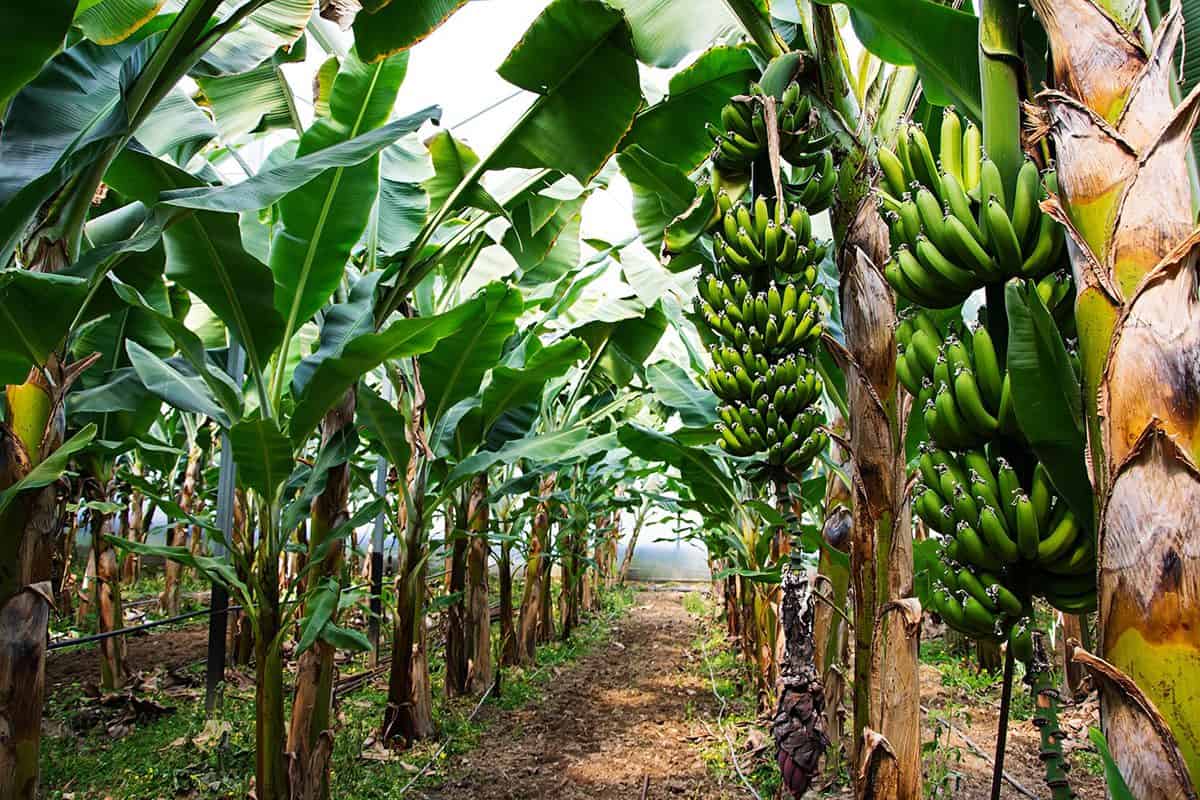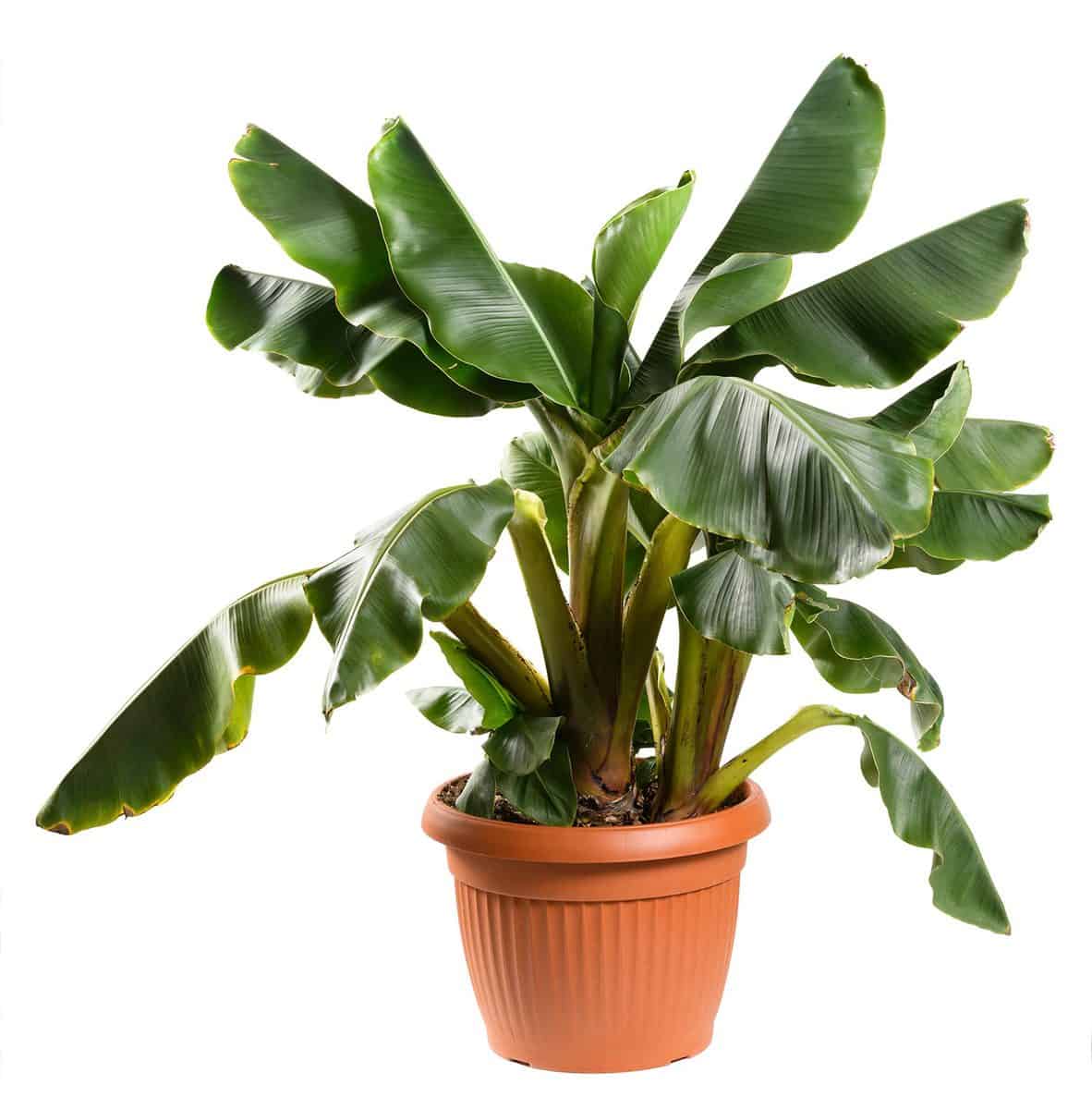This article was reviewed by Steve Snedeker, professional landscaper.
Have you ever enjoyed a banana and wondered why it lacks seeds? Many enjoy eating them without wondering: Why don't bananas have seeds? And if they don't, how does one grow a banana tree?
Banana plants stand tall and are often mistaken for trees. But they're not. They don’t have woody stems but large green leaves and stalks. The fruit is loved worldwide.
But can you plant one using a store-bought banana?
The answer is no. But don't be disheartened!
You can grow a banana plant with the right seeds from a supplier. This article will cover all the details on how to grow a banana tree from seeds.
Let's get started!
From Seed to Fruit: Growing Your Own Banana Tree
Commercial bananas we buy from stores won't help you grow a banana tree. They usually lack seeds.
Instead, to grow your own banana tree, start with procured seeds. Here's the process. We'll cover each step in greater detail throughout the article.
- Soak the seed for 24-48 hours.
- Plant each seed approximately 1 inch deep in permeable soil.
- Maintain soil temperature at 60-68°F.
- Keep soil moist.
- Be patient; germination can occur within 3 weeks or up to 6 months, depending on the variety.
Growing bananas at home can be extremely rewarding. The banana trees are lovely, and the fruit is healthy and delicious.
Keep reading; we’ll explain how to propagate a banana tree from seed.
Different Types of Banana Plants
Bananas are among the most popular fruits globally and come in many varieties. Each variety has unique characteristics such as taste, texture, and color.
When it comes to growing banana plants, choosing a variety that suits your needs and growing conditions is essential.
Below is a table summarizing some of the most common banana varieties:
| Common Names | Botanical Name | Mature Size | Fun Facts |
|---|---|---|---|
| Cavendish | Musa acuminata 'Dwarf Cavendish' | 6-10 ft | Most popular commercial banana |
| Manzano (Apple Banana) | Musa acuminata × balbisiana 'Manzano' | 10-20 ft | Taste reminiscent of apples |
| Ice Cream Banana (Blue Java) | Musa acuminata × balbisiana 'Blue Java' | 15-20 ft | Taste and texture like vanilla ice cream |
| Red Banana | Musa acuminata 'Red Dacca' | 10-15 ft | Sweet taste, reddish-purple skin |
| Plantains | Musa paradisiaca | 10-20 ft | Cooking bananas, not usually eaten raw |
As you can see, bananas come in many diverse varieties, each with its own unique characteristics.
Whether you're a fan of the classic Cavendish, looking for a banana that tastes like apples, or exploring bananas with unique flavors and textures, there's a variety that's sure to satisfy your taste buds.
Remember to research each variety's specific care requirements to ensure you provide the optimal conditions for healthy growth.
Enjoy growing your banana plants and reap the delicious rewards of your efforts!
Where is the Seed in a Banana?
Ever wondered where the seed is in a banana? If you look inside a store-bought banana, you're unlikely to find one.
This is because most bananas we eat, like the Cavendish variety, are bred not to have seeds.
Instead, these bananas grow from offshoots known as suckers or pups.
In the wild, though, bananas do have seeds. These seeds can be so big they dominate the fruit, leaving little pulp to eat. Both these large seeds and suckers help wild bananas grow.
If you want to try growing bananas from seed, you can buy them from online plant suppliers, including Amazon.
How to Grow a Banana Tree from a Seed? [A Comprehensive Guide]

Raising a banana tree from seed can test one's green thumb prowess.
While wild banana seeds germinate and sprout under unique conditions, replicating this magic at home demands dedication and patience.
1. Initiate With A Seed Soak (24-48 Hours)
Soaking the banana seed is essential because wild seeds can only germinate when water reaches the internal embryo.
Banana seeds have a durable outer shell, but it is leaky.
Soaking the seed allows water to permeate the shell slowly, and the internal sexual organs of the seed absorb water to begin the germination process.
See These Dwarf Banana Seeds On Amazon
2. Plant Each Seed in Permeable Soil (1 inch deep)
Use permeable soil to allow drainage. Otherwise, the seed will be prone to rot.
We recommend trying potting soil for the best results.
3. Maintain Soil Temperature at 60-68°F
In the wild, non-dormant banana seeds can lie for several years, waiting for ideal soil temperatures as a cue that it is time for germination.
It is not yet understood how roots sense temperature, but the fluctuation in soil temperature is necessary for successful germination.
Use a heating mat or a heat lamp to increase the temperature of the soil for several hours daily. Let the soil cool to no less than 60°F.
4. Keep Soil Moist

Keep the soil moist to promote germination. If you are planting in a seed tray or pot, cover it with plastic to maintain a humid environment.
5. Be Patient
It takes between 3 weeks and 6 months for banana seeds to germinate.
So, be patient and closely monitor the soil’s moisture level and temperature while you wait.
Even if you provide optimal conditions for germination, your banana seed might be dormant.
A scientific study found that only 68-75% of freshly harvested wild seeds germinated when given the right conditions.
Watch The Germination Process In Detail In The Video Below
Interested in learning other types of seed propagation? Check out our blog post, “How to Propagate Pachira Aquatica (Money Tree).”
Propagation from Banana Stems and Cuttings
Propagating banana trees from stems and cuttings is quicker than from seeds. Here's a simplified guide to get you started:
- Select a Sucker: Choose a healthy banana plant and cut a robust sucker (offshoot) at the base with a sharp, sterilized knife. Sword suckers (small leaves) are preferred for their vigor.
- Prepare the Cutting: Trim the sucker's roots and remove any small or dead leaves, leaving only the central leaves.
- Planting: Plant the cutting in well-draining soil, 2-4 inches deep, in a pot. Water it well.
- Create Ideal Conditions: Place the pot in a warm, humid environment with bright, indirect light, ideally between 65-75°F.
- Care: Keep the soil moist and mist the leaves regularly. Fertilize with a balanced, water-soluble fertilizer every 4-6 weeks.
- Transplant: Once the cutting establishes roots and new growth appears, transplant it to a larger pot or directly into the ground if climate permits.
Following these steps, you can enjoy your own banana plants and potentially a banana harvest in about a year!
How Big Do Banana Trees Get?

Did you know that banana trees are not trees? Bananas are tree-like perennial, herbaceous flowering plants.
They are more closely related to ginger plants and bird-of-paradise flowers than trees.
The rhizome of a banana plant produces a robust pseudo-stem made from dense, overlapping leaves that can reach heights between 10 feet and 25 feet tall, depending on the variety.
Banana trees have broad, fanning leaves that can grow up to 9 feet long and 2 feet wide, depending on the variety.
The leaves are delicate and prone to wind damage, so trees should be planted in a somewhat sheltered location.
Fruits of bananas grow like berries, protruding from the center of the plant’s heart-shaped flower. Individual fruits are called fingers.
A mature banana finger weighs approximately 4 ounces.
Banana fruits grow in tiers of 10-20 fingers, forming massive clusters called hands.
A hand of bananas might contain between 3 and 20 tiers, depending on the variety. When harvested, each hand of bananas can weigh up to 100 pounds.
Growing Banana Trees Indoors
Select the Right Variety
Dwarf banana varieties, like the Musa banana, are ideal for indoor cultivation as they don't require as much space as their outdoor counterparts.
Provide Adequate Light
Banana plants need plenty of light to thrive. Place your plants near a south-facing window or supplement natural light with grow lights. They should receive at least 6-8 hours of sunlight daily.
Maintain Humidity and Temperature
Bananas thrive in warm, humid environments. Keep indoor temperatures between 65-75°F and use a humidifier or mist the leaves to increase humidity.
Water and Fertilize Regularly
Keep the soil consistently moist but not soggy. Fertilize your banana plant monthly with a balanced, water-soluble fertilizer to encourage healthy growth and fruit production.
Pruning
Remove any dead or yellowing leaves and suckers (small shoots) that might compete with the main plant for nutrients.
Potting and Soil
Choose a large, well-draining pot or container for your banana plant. Use a high-quality potting mix with organic matter and ensure proper drainage to prevent root rot.
Best Containers for Growing a Banana Tree?

Potted bananas are dwarf varieties that grow between 5 feet and 15 feet tall, depending on the variety.
Because the size of the container can inhibit the banana’s growth, you will want to select a container large enough to provide a roughly 3-inch gap between the container’s sides and the centered pseudostem of the plant.
As your banana tree grows, transplant it into a larger container.
Here are a few things to consider when selecting a container for your banana tree:
- Drainage; equipped with a bottom hole(s) and (for smaller, indoor/outdoor pots) coordinating saucer.
- Lightweight material; to quickly relocate more giant, heavy trees.
- Durable material; for indoor/outdoor use so the container will not become discolored or break easily.
- Reusable; to repurpose the container after banana trees have been transplanted.
- Style; to coordinate with indoor/outdoor decor.
Sow banana seeds in a reusable tray with a humidity lid. Heavy-duty plastic with grip handles is easy to locate in a sunny location after planting.
Click Here To Find This On Amazon
Transplant banana seedlings into 3-inch pots. Multipurpose terra cotta pots with drainage and saucer prove versatile planters throughout your home and yard.
Click Here To Find This Pot On Amazon
The perfect size to nourish an emerging banana corm or sucker, this set of three ceramic (5-inch, 7-inch, and 9-inch) pots will give plants a great start.
Modern style compliments home decor, with drainage and coordinating saucer for healthy plants.
Click Here To Find This On Amazon
Boldly display your growing banana tree planted in this sleek ceramic pot.
Available in 8-inch and 10-inch sizes to accommodate hearty plants, with a drainage hole and stopper.
Click Here To Find These Pots On Amazon
Add color to your tropical landscape by planting bananas in this 15-inch pot.
Durable, high-density resin withstands outdoor elements with a gleaming ceramic-like finish.
Click Here To Find This Patio Pot On Amazon
Accentuate your banana tree by planting in this stylish 20-inch pot.
Lightweight, double-walled polyresin material makes locating your banana indoors or outside easy—puncture drainage holes for adequate moisture.
Click Here To Find These Pots On Amazon
Check out our blog, “10 Best Walmart Large Flower Pots and Planters,” for even more container ideas.
Now that you know how to propagate a banana tree from seed, you can get started so that you will soon have a flourishing, young plant to produce wholesome fruit.
Frequently Asked Questions
1. Can I grow a banana tree from a store-bought banana? You cannot produce a banana tree from a store-bought banana.
Commercially grown bananas are typical of the Cavendish variety, which is seedless.
Instead, you can develop a banana tree from seeds (available from specialized suppliers), suckers, or corms.
2. How long does it take for a banana tree to produce fruit? A banana tree typically takes 9 to 12 months to make fruit after planting a sucker or corm.
Depending on the variety and growing conditions, it may take 2 to 4 years from seed to start producing fruit.
3. Do banana trees need a lot of sunlight? Yes, banana trees thrive in full sun and need at least 6 to 8 hours of daylight daily.
They can tolerate some shade, which may slow their growth and reduce fruit production.
4. How often should I water my banana tree? Banana trees need regular watering to thrive. Keep the soil consistently moist but not soggy.
Water the tree deeply once a week and more frequently during hot, dry periods.
5. Can I grow a banana tree indoors? Yes, you can grow banana trees indoors, especially dwarf varieties.
Provide plenty of sunlight through a south-facing window or supplement with grow lights. Keep the soil moist and maintain high humidity levels for optimal growth.
6. How do I propagate a banana tree from a sucker? To propagate a banana tree from a sucker, carefully dig up a tiny sucker (pup) from the base of an established banana plant.
Remove attached roots from the main plant and replant the sucker in well-draining soil. Keep the soil moist and provide adequate sunlight.
7. Do I need to fertilize my banana tree? Yes, banana trees benefit from regular fertilization. Use a balanced fertilizer with equal nitrogen, phosphorus, and potassium.
Follow the package instructions to apply the fertilizer every 4-6 weeks during the growing season.
8. How do I protect my banana tree from pests and diseases? Look for common banana tree pests like spider mites, aphids, and nematodes.
Remove affected leaves and use insecticidal soap or neem oil as needed. To prevent diseases, ensure proper spacing, avoid overhead watering, and remove any dead or diseased plant material.
9. When should I harvest my bananas? Harvest bananas when they are still slightly green but have started to plump up.
The ridges on the bananas will become less pronounced, and the fruit will begin to fill out. Cut the entire stalk and let the bananas ripen indoors.
10. How do I prune my banana tree? Prune your banana tree by removing dead or yellowing leaves and any suckers competing with the main plant.
After the tree has produced fruit, cut down the main stem to about 2-3 feet above the ground, as it will not make fruit again. Leave the suckers to grow and become the new fruit-bearing plants.
Nurturing Your Banana Tree to Flourish: Key Takeaways
Growing a banana tree, whether from a seed or a cutting, is a rewarding endeavor that requires patience, knowledge, and the right conditions:
- Essentials: Ensure proper soil drainage, maintain the right temperature, and provide adequate light.
- Patience is Key: From germination to fruit-bearing, the banana tree journey is a test of time and dedication.
- Choose Your Approach: Whether you opt for seeds or cuttings, ensure you follow the proper steps for successful propagation.
- Indoor vs. Outdoor: Depending on your climate, decide the best environment for your banana tree.
Have fun on this exciting cultivation journey, and don't hesitate to reach out with your experiences or questions.
For more insights, check out our other plant-growing guides.
Use this image to add this article to your Pinterest board:









Is there anywhere in Tasmania fruiting Banana palms can be obtained?
Where can you get banana seeds from please thank you.